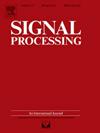Closed-form expression for resolution limit of direction-of-arrival estimation in co-prime array
IF 3.4
2区 工程技术
Q2 ENGINEERING, ELECTRICAL & ELECTRONIC
引用次数: 0
Abstract
Utilizing co-prime linear arrays (CLA) in place of uniform linear arrays can greatly improve the direction-of-arrival (DOA) resolution with the same number of elements. However, the explicit DOA resolution limit (DRL) of the CLA is unavailable and the resolution gain has not been investigated sufficiently. In this work, Shannon’s information theory is utilized to establish the closed-form expression of the DRL of the CLA. For complex Gaussian sources, we derive the scattering information of duo-source whose amplitudes are the same. A critical state is picked in which the scattering information’s quadrature part equals 1 bit, and the DOA separation is determined to be the DRL. The explicit DRL is then obtained by a Taylor expansion, which is algorithm-independent and can be applied to all signal-to-noise ratios. The expression illustrates that the DRL is approximately inversely proportional to the direction cosine, the root-mean-square aperture width, and the square root of the signal-to-noise ratio. In addition, the quantitative relationship between the number of elements, sparse array aperture, and the optimal resolution limits of three kinds of common-used sparse arrays is obtained, which is of practical significance to the sparse array design.
共素数阵列到达方向估计分辨率极限的封闭表达式
利用共素线性阵列(CLA)代替均匀线性阵列,可以在相同元数的情况下大大提高到达方向(DOA)分辨率。然而,CLA的明确DOA分辨率限制(DRL)是不可用的,分辨率增益也没有得到充分的研究。本文利用香农的信息论建立了CLA的DRL的封闭形式表达式。对于复高斯源,导出了振幅相同的双源散射信息。选取散射信息正交部分等于1比特的临界状态,确定DOA分离为DRL。然后通过Taylor展开获得显式DRL,该展开与算法无关,可应用于所有信噪比。该表达式表明,DRL与方向余弦、均方根孔径宽度和信噪比的平方根近似成反比。此外,还得到了三种常用稀疏阵列的元数、稀疏阵列孔径和最优分辨率极限之间的定量关系,对稀疏阵列设计具有实际意义。
本文章由计算机程序翻译,如有差异,请以英文原文为准。
求助全文
约1分钟内获得全文
求助全文
来源期刊

Signal Processing
工程技术-工程:电子与电气
CiteScore
9.20
自引率
9.10%
发文量
309
审稿时长
41 days
期刊介绍:
Signal Processing incorporates all aspects of the theory and practice of signal processing. It features original research work, tutorial and review articles, and accounts of practical developments. It is intended for a rapid dissemination of knowledge and experience to engineers and scientists working in the research, development or practical application of signal processing.
Subject areas covered by the journal include: Signal Theory; Stochastic Processes; Detection and Estimation; Spectral Analysis; Filtering; Signal Processing Systems; Software Developments; Image Processing; Pattern Recognition; Optical Signal Processing; Digital Signal Processing; Multi-dimensional Signal Processing; Communication Signal Processing; Biomedical Signal Processing; Geophysical and Astrophysical Signal Processing; Earth Resources Signal Processing; Acoustic and Vibration Signal Processing; Data Processing; Remote Sensing; Signal Processing Technology; Radar Signal Processing; Sonar Signal Processing; Industrial Applications; New Applications.
 求助内容:
求助内容: 应助结果提醒方式:
应助结果提醒方式:


